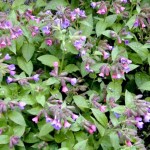Written by Rich Blankenship
Living in a house on a lot with numerous large shade trees can be challenging to a gardener who is constantly looking for that small sliver of sunlight to grow sun-loving plants. Lusting over the plethora of flowering perennials that worship the sun that you don’t have in your yard can be frustrating. Trying to grow them in too little light can be a huge let down. Most gardeners eventually give up and turn to the one plant they know that will thrive in the shadiness of their sun-strapped garden spaces. Hostas! While hostas are beautiful plants, and have their place in the shade garden, an abundance of lesser known shade plants means an opportunity for so much more.
Shade gardens can be just as enjoyable as those with plentiful sunlight, especially if you look beyond the genus Hosta to the many other wonderful shade plants available. These plants offer many outstanding attributes including flower, form, texture, and color. They can transform those shady, dark garden spaces into bright, glowing, and enchanting gardens worthy of a magazine cover.
Some of my favorites include; Astilbe (False Spirea), Helleborus niger (Lenten Rose), Hakonechloa (Forest Grass), Ferns, Alchemilla mollis (Lady’s Mantle), Anemone hupehensis (Wind Flower), Brunnera macrophylla ( Perennial Forget-Me-Not), Dicentra spectabilis (Bleeding Heart), Epimedium (Barrenwort), Lamium (Dead Nettle), Pulmonaria (Lung Wort), Polygonatum (Solomon’s Seal) and Trycyrtis hirta (Toad Lilly). All of these perennials are great companions to each other and offer a wide range of seasonal interest carrying the garden from spring to fall. Hostas actually make more sense when married with some or all of these fine garden plants and should be included in small numbers.
The biggest key to any great garden, beyond the plants that inhabit it, is the soil. Incorporation of a good compost material into the soil is important for good root development and also drainage. A general purpose fertilizer should be applied throughout the growing season in periodic intervals and supplemental watering during dry periods is encouraged. Maintaining healthy plants is critical to success.
Gardening in the shade doesn’t have to be frustrating or a curse but can be an opportunity to become familiar with and work with a new group of exciting perennials. By paying attention to nutrient and watering demands, and incorporating the proper plants, the dark and lonely spaces beneath the canopies of those mature trees can be transformed into a shade garden to rival the sunniest perennial border.


